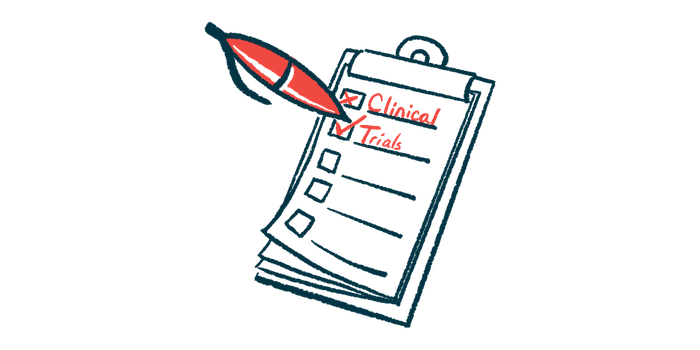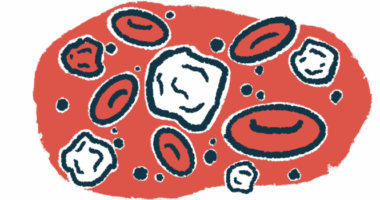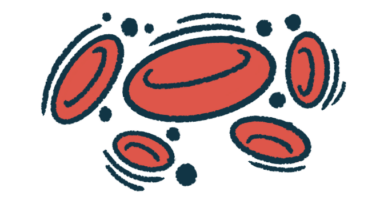Complement inhibitor HRS-5965 safe, effective in PNH patients
Therapy reduced red blood cell destruction, increased hemoglobin levels

Treatment with HRS-5965, a complement inhibitor being developed by Jiangsu Hengrui Pharmaceuticals, increased the levels of hemoglobin and reduced red blood cell destruction in people with paroxysmal nocturnal hemoglobinuria (PNH), according to data from a clinical trial.
Data from the Phase 2 trial (NCT06051357), which assessed the safety and efficacy of the therapy in 26 adults with PNH who were not previously treated with a complement inhibitor, also demonstrated that HRS-5965 had a favorable safety profile.
According to researchers, these results suggest HRS-5965’s “potential as a promising oral therapy for complement inhibitor-naïve PNH patients.”
The study, “Efficacy and safety of HRS-5965 monotherapy in complement inhibitor–naïve patients with paroxysmal nocturnal haemoglobinuria,” was published in the British Journal of Haematology.
HRS-5965 targets key enzyme
PNH is caused by the abnormal activation of the complement cascade, a group of immune proteins, resulting in the destruction of red blood cells, or hemolysis. This leads to anemia — a decrease in red blood cell counts or in the levels of hemoglobin, the protein that carries oxygen in red blood cells — accompanied by other symptoms.
HRS-5965 is a novel oral small-molecule inhibitor that selectively targets complement factor B, an enzyme needed for the activation of the C3 complement protein within the alternative pathway. It is aimed at reducing complement activation and potentially reducing hemolysis occurring both inside and outside blood vessels.
In the Phase 2 trial, participants were randomly assigned to one of two treatment groups. A titration group was given HRS-5965 at a dose of 50 mg, twice daily, for two weeks, with the possibility to increase the dosage to 100 mg twice daily for the remainder of the 12-week treatment, depending on response. A fixed-dose group received HRS-5965 at a dose of 75 mg, twice daily, during the entire 12-week treatment period.
Patients had a median age of 39.5 years and were mainly men (61.5%). At baseline, or before the start of treatment, all showed signs of hemolysis, including having high levels of lactate dehydrogenase (LDH), a marker of red blood cell destruction, and anemia. More than half were dependent on blood transfusions and received transfusions in the year preceding the trial.
After three months of treatment, hemoglobin levels increased by about 3.8 g/dL, while LDH levels dropped by 85% to 87% to nearly normal levels. This indicates a reduction in intravascular hemolysis, or red blood cell destruction inside blood vessels.
Other markers of hemolysis also decreased with treatment, including reticulocyte count, or the number of immature red blood cells, free hemoglobin, and bilirubin.
Most patients achieved transfusion independence
All patients in the titration group and 83.3% of those in the fixed-dose group achieved transfusion independence, defined as having an increase in hemoglobin levels of at least 2 g/dL. A quarter of patients in both groups saw their hemoglobin levels normalize, or reach 12 g/dL, without blood transfusions. One patient in the titration group required a blood transfusion during treatment.
Most participants in both groups experienced adverse events: 69.2% in the titration group and 92.3% in the fixed-dose group. Treatment-related adverse events were reported in 30.8% of the patients in the titration group and in 76.9% of those in the fixed-dose group.
Although the treatment duration was relatively short, these results reflect a promising therapeutic response that is likely to continue improving with longer treatment exposure.
Adverse events were generally mild and included upper respiratory tract infections, increased levels of liver enzymes, and high levels of triglycerides, a type of fatty molecule, and C-reactive protein, a marker of inflammation.
Serious adverse events were reported in 7.7% of the patients in the titration group and in 15.4% of those in the fixed-dose group. None was considered to be related to treatment. No deaths were reported.
“Although the treatment duration was relatively short, these results reflect a promising therapeutic response that is likely to continue improving with longer treatment exposure,” the researchers wrote. “HRS-5965 achieved rapid and robust suppression of intravascular haemolysis … [indicating] that HRS-5965 can promptly protect treatment-naïve patients from haemolysis-driven complications.”









